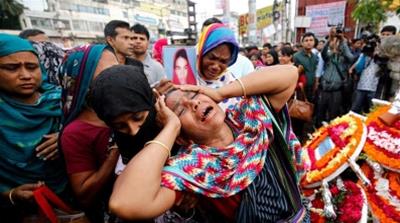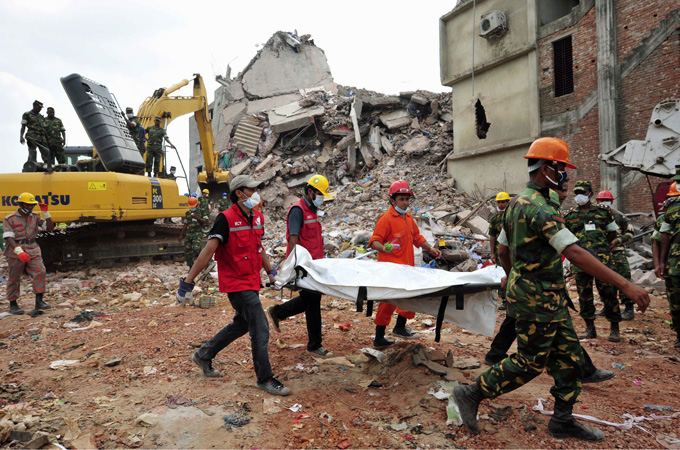
Dhaka, Bangladesh – It has been 10 years but the trauma of gasping for breath under debris for more than 10 hours still haunts Rehnuma Akter.
On the fateful day of April 24, 2013, Akter went to work at a garment factory in Bangladesh’s Savar city outside capital Dhaka that produced readymade clothes for a British fashion brand.
An hour after her shift started, Rana Plaza, the nine-storey building that housed her garment factory along with four others, collapsed into a heap of bricks, machines and factory bolts.
Akter was lucky. She survived one of the deadliest industrial disasters. However, by the time a weeklong rescue operation ended, a total of 1,134 lives were lost beneath the rubble.

Akter, now 34, never worked in a garment factory again. After her stints as a domestic help, she is now working as a cleaner at a private hospital in Dhaka.
“I can never go back to any factory. That memory of Rana Plaza still gives me nightmares,” she told Al Jazeera.
Like her, more than 63 percent of Rana Plaza survivors did not work in a garment factory again, said a report by ActionAid NGO, released this year.
The Rana Plaza disaster had a profound and lasting negative effect on the lives of its survivors. But for the readymade garment (RMG) industry of Bangladesh – the mainstay of its $460bn economy – it brought titanic shifts.
From shoddy sweatshops that cared little for the working conditions of its workers, more than 80 percent of Bangladesh’s 3,200 RMG factories are now internationally compliant with safety and security standards, according to data released by the Bangladesh Garments Manufacturer and Exporters Association (BGMEA), the country’s apex trade body for apparel producers.
At present, the South Asian nation is home to half of the world’s top 100 Leadership in Energy and Environmental Designs (LEED)-certified green industrial units, according to a report in the Business Standard newspaper in February. In fact, a firm called Green Textile Limited topped the 2023 LEED list prepared by the United States Green Building Council (USGBC).
A 2021 report by McKinsey consultancy dubbed Bangladesh’s RMG sector a frontrunner in transparency regarding factory safety and value-chain responsibility. Another report by QIMA, a global supply chain compliance solutions provider, ranked the country second in the ethical manufacturing index the same year.
Bangladesh also amended its labour law twice – in 2013 and 2018 – to safeguard workers’ rights and to ensure safety at the workplace.

How the transformation happened
So what caused a significant transformation in the safety standards of Bangladesh’s garment factories?
After the Rana Plaza incident, leading global retail brands signed up for two international efforts to improve factory standards.
The Accord on Fire and Building Safety in Bangladesh and the Alliance for Bangladesh Workers’ Safety are two bodies that helped the country’s factories improve and standardise their fire, structural and electrical safety measures.
The Alliance left the country in 2018, claiming a 93 percent remediation rate across 700 factories it inspected, while the Accord, which lasted until 2020, helped standardise fire and building safety in more than 2,000 RMG factories.
After their departure, the RMG Sustainability Council (RSC) – an entity comprised of RMG manufacturers, global brands and retailers, and global unions and their Bangladeshi affiliates – was formed in 2020 and given the same tasks.
“RSC is a very unique organisation as it brings three stakeholders with hugely different mindsets under one umbrella to improve safety standards in industrial units. This is probably the first of its kind in the whole world,” Rubana Haq, an RSC board member, told Al Jazeera.

Since the RSC is licensed by the Bangladesh government, national ownership and accountability are inserted here as well, she added.
“The collective national tragedy of Rana Plaza taught us a lesson, and as a result, we all worked together to achieve a full remediation of the whole RMG industry,” said Haq, also a former president of Bangladesh Garments Manufacturer and Exporters Association (BGMEA), the country’s apex trade body for apparel producers.
According to a report by the International Finance Corporation (IFC), Bangladesh’s clothing industry grew by 79 percent from $19bn in 2015 to $34bn in 2022, making the country the second-largest apparel exporter in the world while accounting for more than 80 percent of its export earnings.
“The RMG sector witnessed a massive growth as we have brought an ethical and safe manufacturing revolution in the past few years. Unfortunately, it has happened at the cost of a great tragedy,” said Faruque Hassan, the president of BGMEA. “But we have learned our lessons and took actions accordingly.”
Areas of focus
Workers in Bangladesh say they now feel safer inside a garment factory.
“The building where I work has everything I like spacious floors with proper ventilation. It also has fire escape and we have regular fire safety drills,” Mansura Begum, an employee of Fatullah Apparels, told Al Jazeera.
Begum’s knitwear manufacturing factory, located on a 2.7-acre (1.1-hectare) plot of land in Narayanganj, some 30km (19 miles) away from Dhaka, is a LEED Platinum-certified industrial unit. Its owner Fazlee Shamim Ehsan says he has invested millions of dollars to make the factory as worker-friendly as possible.
“We are operating on tight margins to meet the international brands’ desire to keep costs down. But out of responsibility and care for my workers, I have made sure the best possible workplace environment for them,” Ehsan told Al Jazeera.

Bangladesh currently has a total of 187 LEED-certified garment factories and 500 more are in the pipeline for getting the certification, according to the BGMEA data.
Before the Rana Plaza incident, the country had only two LEED-certified factory units.
Amirul Haque Amin, president of the National Garment Workers Federation, said workplace conditions for the RMG workers have “obviously improved” over the last decade.
“But that doesn’t mean the industry is fully safe and there are no areas for improvement,” he told Al Jazeera.
A 2016 report by the International Labor Organization (ILO) said at least 35 textile factory accidents took place in Bangladesh since the Rana Plaza disaster.
That year, a total of 24 people died in a single boiler explosion at Tampaco Foils Ltd, a packaging factory in Tongi on the outskirts of Dhaka. A year later, 13 people died after a boiler exploded at Multifabs Ltd, a textile factory in the Gazipur district.
“Those 37 workers died in just two accidents and both happened in the boiler rooms of the factories,” Amin said.
Incidentally, boiler inspection was not within the scope of Accord or Alliance which had the mandate to inspect fire, electrical and structural safety only. The RSC however has incorporated a boiler safety programme since its inception in 2020.
Amin, who is also the labour union representative in the RSC, told Al Jazeera the problem with periodic boiler inspection is that for more than 5,000 active industrial boilers in Bangladesh, there are only six government-appointed inspectors.
“It is nearly impossible to inspect such large numbers of boilers with this manpower. The government should take immediate measures in this regard,” he said.







